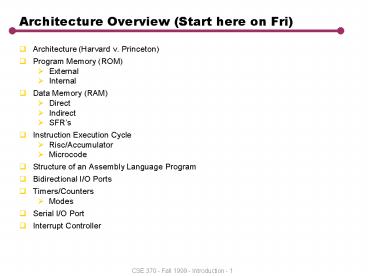Architecture Overview (Start here on Fri) - PowerPoint PPT Presentation
Title:
Architecture Overview (Start here on Fri)
Description:
8051: Modified Harvard ... Byte and Register Exchange operations Assembly Programming Declare Segments and Segment types ... PIC 8-pin Microcontroller Middle ... – PowerPoint PPT presentation
Number of Views:144
Avg rating:3.0/5.0
Title: Architecture Overview (Start here on Fri)
1
Architecture Overview (Start here on Fri)
- Architecture (Harvard v. Princeton)
- Program Memory (ROM)
- External
- Internal
- Data Memory (RAM)
- Direct
- Indirect
- SFRs
- Instruction Execution Cycle
- Risc/Accumulator
- Microcode
- Structure of an Assembly Language Program
- Bidirectional I/O Ports
- Timers/Counters
- Modes
- Serial I/O Port
- Interrupt Controller
2
Simple Princeton Architecture
ROM Linear Address Space W/ Mem Mapped
IO/SFRs
I/O Port
PC
SP
GPRs
IR
Timer, SFRs
RAM
address
ALU
Reset Vector
Interrupt Vect
IR
mux
data
Status
Control
3
Analysis
- Bottleneck into and out of memory for data and
code - Use of critical 8-bit address space (256) for
memory mapped I/O and special function registers
(timers and their controllers, interrupt
controllers, serial port buffers, stack pointers,
PC, etc). For example, the Motorola 6805
processor has only 187 RAM locations. - But, easy to program and debug. Compiler is
simple too.
4
8051 Modified Harvard Architecture
PC
mux
address
Internals
RAM
SFRs (direct)
Reset Vector
Usually Stack (indirect)
ALU
Interrupt Vect
Interrupt Vect
Interrupt Vect
8051 standard Enhancements
(indirect or Direct)
Bit Addressable
Status
Reg. Banks
data
Control
5
8051 Memory Architecture
- Advantages
- Simultaneous access to Program and Data store
- Register banks great for avoiding context
switching on interrupt and for code compression - 8-bit address space extended to 256128 384
registers by distinguishing between direct and
indirect addressing for upper 128 bytes. Good for
code compression - Bit addressable great for managing status flags
- Disadvantage
- A little bit confusing, with potential for
errors.
6
Instruction Execution
- 6 states/machine cycle, 2 clocks/state 12
clocks/machine cycle. Some instructions take two
machine cycles, most take one. - Can make two ROM accesses in on memory cycle?
(three byte inst) - More like CISC than RISC
- Interesting features
- No Zero flag (test accumulator instead)
- Bit operations
- Read Modify Write operations (ports)
- Register to Register Moves
- Integer arithmetic
- Signed arithmetic
- Byte and Register Exchange operations
7
Assembly Programming
- Declare Segments and Segment types
- Assembler converts to machine code, with
relocatable segments. - Linker perform absolute code location
- Segments
- DATA
- IDATA
- PDATA
- XDATA
- CODE
- CONST
- Example Assembly Program
8
Anatomy of an Assembly Program
Look for overflow in C difficult to do
unsigned int i void main (void) unsigned
int tmp while (1) P1 0x01 i 0 do
tmp i i P2 while (tmp lt i)
Note i is global and tmp is local. What happens
to local variables? How are registers used? What
happens in a subroutine call?
9
Now in Assembly
RSEG PROG first set Stack
Pointer START MOV SP,STACK-1 CLR flag
just for show SETB flag just for
show LOOP1 CLR C Clear carry MOV
A,il ADD A,P2 increment MOV
il,A JNC LOOP1 loop until carry INC
ih increment hi byte MOV A,ih
check if zero JNZ LOOP1 XRL
P1,01H SJMP LOOP1 END
NAME FLASH PUBLIC il PUBLIC ih PROG SEGMENT COD
E CONST SEGMENT CODE VAR1 SEGMENT DATA BITVAR SEG
MENT BIT STACK SEGMENT IDATA RSEG BITVAR flag
DBIT 1 RSEG VAR1 ih DS 1 il DS
1 RSEG STACK DS 10H 16 Bytes
Stack CSEG AT 0 USING 0
Register-Bank 0 Execution starts at address 0
on power-up. JMP START
10
Compiled C
But, here is the optimized Compiled C
?C0001 XRL P1,01H CLR A MOV i,A MOV
i01H,A ?C0005 MOV R7,i01H MOV R6,i MOV
R5,P2 MOV A,R5 ADD A,i01H MOV
i01H,A CLR A ADDC A,i MOV i,A CLR
C MOV A,R7 SUBB A,i01H MOV A,R6 SUBB
A,i JC ?C0005 SJMP ?C0001
11
I/O Ports
- Input ports Hi Input impedance (like CMOS
transistor gate) - Output ports Hi drive (current source/sink)
capability (like CMOS transistor channel) - Bidirectional Ports?
- Weak Pullup Approach used in the 8051
- Configuration bits (used in other MCUs)
12
Basic Electronics
- Speaker Interface. Design a direct drive circuit
for the speakers. How much power are we
dissipating in the speaker if we stay within
current rating of chip? - How can we get more power to the speaker?
- Note to self Saturation v. Linear operation
13
Lab 2
- Design and implement Audio Amplifier interface to
8051. - Simple program (in assembly) that can generate a
controllable range of audio frequencies (like
lab1, but different range of frequencies and use
interrupts instead of busy waiting). - Use interrupts to generate the pulse trains
- Any algorithm suggestions? Lets keep it simple!!
- Lab write-up
- Characteristics of your speaker min max tone
frequency, audibility (loadness) v. frequency,
etc. Anything else you notice - Are your drive transistors operating in linear or
saturation mode? How can you tell? - Resource Utilization Analysis
- of time in ISR (can you minimize this?)
- Worst case stack size
14
Embedded Hardware
- Microcontrollers
- Smallest PIC 8-Pin (8-bit) PIC 8-pin
Microcontroller - Middle 6805 (8 bit) Example Flash Based 8051
- Many 16-bit DSP Microcontrollers
- HW support for MAC, Filter Algorithms
- High End StrongArm (32 bit) Intel
- Compare to pentium
- External memory
- Data Address Multiplexing
- Memory Mapped I/O
- Device Interfaces
- Resistive Sensors (Strain, Temp, Gas, etc.)
- Motion sensors (accelerometer)
- Valve
- Motor (Stepper, DC, Servo)\
- Speaker
- LCD Display
- LED
- Latches

